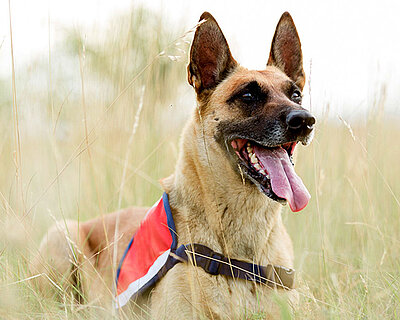
Tick-borne diseases: Anaplasmosis
If your dog develops flu-like symptoms such as weakness and fever and has recently been bitten by a tick, these may be signs of anaplasmosis. Our vet Dr Alexander Hönel explains what anaplasmosis is and how it develops in dogs.
Anaplasmosis is a tick-borne infectious disease that is already widespread in Central Europe. It affects not only dogs, but also cats, foxes, horses and humans. The disease is caused by a bacterium that is transmitted to the tick by rodents, for example.
Anaplasmosis is not directly transmittable between dogs and humans.
Dr Alexander Hönel, IRO Veterinarian and Deputy Spokesperson for Deployment
The disease is mainly transmitted by the bite of the deer tick, the most widespread species of tick in Europe. If the disease breaks out, various, rather unspecific clinical signs usually become noticeable 2–21 days after a tick bite – similar to babesiosis:
- Fever
- Lethargy
- Lack of appetite
- Reluctance to move
- Bleeding, for instance nosebleeds
- Lameness and other neurological signs (seizures, balance issues)
- Behaviour change
- Enlarged spleen and liver
- Inability to work*
After the tick bite, the pathogens spread throughout the body via the bloodstream and infect various organs such as the liver, spleen and central nervous system. In order to diagnose and treat anaplasma infection in dogs, the vet takes blood samples and initiates an examination including immunological tests. If the suspicion is confirmed, the blood test will show a reduction in blood platelets (thrombocytes), which are responsible for blood clotting. For this reason, anaplasmosis in dogs can lead to bruising or bleeding (including nosebleeds) and, in cases of severe blood loss, to pale mucous membranes.
The treatment involves the use of an antibiotic. With early and correct treatment, the chances of a rapid improvement are very good – however, complete elimination of the pathogens is not guaranteed. There is no vaccination against the disease, which is why targeted tick prophylaxis is particularly important.
Effective tick prevention is the best way to protect your dog. This includes using anti-tick products as well as regularly checking your furry friend after walks and outdoor activities.
* This applies to working dogs such as assistance dogs, guide dogs for the blind, service dogs and search and rescue dogs.
Author: Dr. Alexander Hönel
Photos: João Victor Xavier, Unsplash

